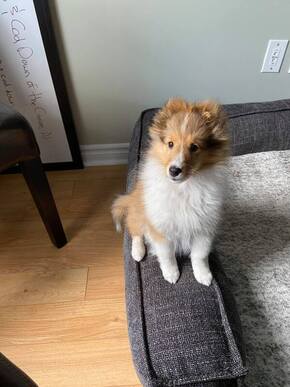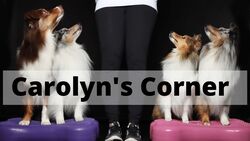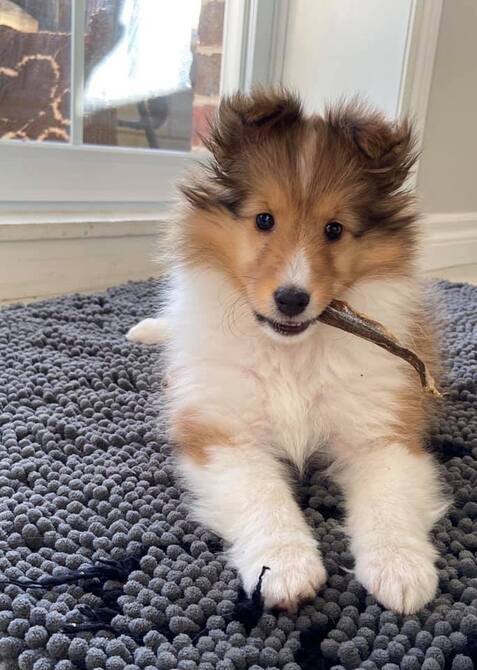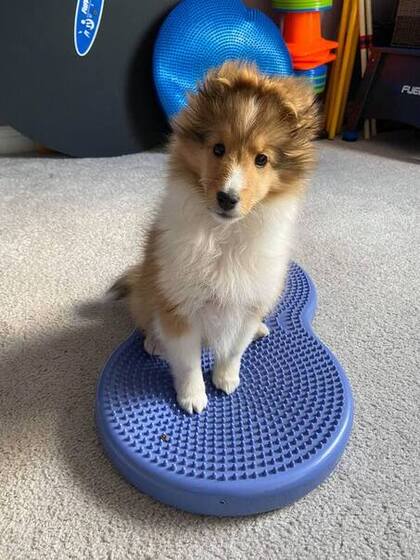|
Getting a new puppy is an exciting and busy time. Something I was just reminded of as I brought home the latest addition to my pack a couple of weeks ago. A small, sassy girl I have named Keeper. It's amazing how easy it is to forget how MUCH work a puppy is and I'd be lying if I said I wasn't a little overwhelmed with the amount of work we had ahead of us. Once your puppy comes home they begin an intensive learning period as they become accustomed to the routine of their new home, begin to learn basic commands, and start foundation work for future performance endeavours. But you may be wondering, how to introduce your puppy to canine conditioning. The good news is that a lot of the skills you'll need for a future in sport can also be taught as you are building your canine conditioning foundation skills. This week I'll discuss what we can do to start getting our puppies ready for conditioning work down the road. Growth Plates and Puppy DevelopmentGrowth plates are soft areas of developing cartilage tissue found by the ends of the dog's long bones. They are typically made of cartilage when the puppy is born, but gradually they calcify and transform into denser bone as the puppy matures. Growth plates are the weakest areas of a growing skeleton and are very vulnerable to injury so protecting our puppies from injury is very important during this time. The growth plates are particularly vulnerable to hard impact and too much exercise. Be mindful that puppies lack both coordination and muscle strength when they're young and are therefore more prone to injury! This is why myself, vets, and other canine health professionals stress the importance of age appropriate exercise and play. At this stage of the game we're not really conditioning our dogs at all!!! Instead, we are building confidence around the equipment, building a strong relationship with our puppies and introducing some rudimentary skills. You're going to want to take some care with your pup while they're in this stage of their development. I've listed here some key things to keep in mind to prevent injury to growth plates.
An injury to a growth plate may result in damaged cells that will stop growing on one side resulting in deformity. Ensuring your puppy is engaging in age appropriate exercise is a crucial step in their development. Rushing into conditioning and sport training will only cost you in the long run! Remember, that an injury to a puppy can have lifelong consequence so while you don't want to bubble wrap your puppy you want to make sure that they're engaging in safe and age-appropriate activities. What can we safely do with our puppies?The first and most important thing we can do with our puppies is teach them how to use their bodies! As I mentioned, puppies are often prone to injury because they lack both muscle strength and coordination. Teaching our dogs to become a bit more mindful of their body will help reduce injury and prepare them for a future in sport. My puppies get introduced to my dog gym as early as 8 weeks! However, my expectations and training with my new puppy are quite different than my seasoned adult dogs. My goals in the first few weeks of having a puppy are focussed on getting them exposed to a variety of size/age appropriate stable and unstable pieces of equipment. When choosing equipment, I look for pieces that are different colour, shape and size. The more variation the better! The actual execution of any specific behaviour with the equipment does NOT matter at this stage. I want to make sure my puppy is confident and happy around all the different pieces and eager/willing to interact with them. Initially, my training sessions might last 3 minutes. This is normal. I always want to make sure my puppy wants to come back for more. Below is a list of exercises that I like to work on with my young dogs (less than 6 months) to start them on the right track!! Keep in mind, EVERY puppy is different. Some will learn quicker than others and some will need more time building confidence while they interact with certain pieces of equipment. When selecting the equipment to introduce keep in mind what may be unsafe for your dog - making sure you're selecting equipment that is appropriately size for your dog, is burst resistant, and has anti-slip material. The key during your training sessions is to have FUN, keep it short, and use treats your dog loves!! If they love the game of tug, you can also incorporate that. We want the puppy gym to be an exciting place where they are positively reinforced for early foundation work.
Common Questions Keeper sitting on the bumper of a dog bed. Getting used to a different and unstable surface. This behaviour is something she likes to do and is not something I ask of her! Keeper sitting on the bumper of a dog bed. Getting used to a different and unstable surface. This behaviour is something she likes to do and is not something I ask of her! Q: How many reps and sets should I be doing?? A: NONE!!! We do not start to actually "condition" our dogs until their growth plates are closed and this can vary depending on the size and breed of your dog. Grab 5-8 cookies and work on an exercise. Also, we should never be asking a young puppy to hold endurance on any piece of equipment - that will come!! Q: What happens if my dog is unsure of a piece of equipment? A: Take it slow. There is never a rush. For dogs that are unsure, I may alter the piece of equipment I am using (e.g. if they are unsure about the wobble board, I may place some towels underneath it to make it less wobbly). For new equipment introductions, I will always reward when the dog looks, faces or interacts with the piece of equipment in any way, shape or form. Remember to always make it a positive experience. Never force your puppy onto a piece of equipment - this is a recipe for disaster and fear! Q: How high should the equipment be? Is there any pieces that are off limits? A: This will depend on the size of your puppy but as a general rule or thumb, nothing higher than their wrist or carpus! We all know how clumsy puppies can be and we don't need an awkward fall off a higher piece of equipment. Safety first!! Q: Can my puppy do stairs? A: When it comes to stairs and growth plates the general consensus is that young dogs should avoid stairs. Stairs require a repetitive motion and impact which can lead to injury to vulnerable plates. Research has shown that puppies < 3 months old should not be allowed access to stairs which is especially true for a large or giant breed of puppy that take longer to develop. I've added a video that I've posted previously on some fun exercise you can do at home with either a Lollipup or with an age/height appropriate piece of equipment. These types of training sessions are not just a great way to build body awareness and proprioception but also a great way to build a relationship with your new dog. If you ever need guidance on finding appropriate exercises for your puppy, or inquiries on when and how to safely progress an exercise don't hesitate to reach out to me either on my Facebook page or email. SourcesDuerr FM, Duncan CG, Savicky RS, Park RD, Egger EL, et al. (2007) Risk factors for excessive tibial plateau angle in large-breed dogs with cranial cruciate disease. J Am Vet Med Assoc 231: 1688–1691.
Krontveit, Randi I., and Ane Nødvedt, Bente K. Sævik, Erik Ropstad, and Cathrine Trangerud. “Housing – and exercise-related factors associated with the development of hip dysplasia as determined by radiographic evaluation in a prospective cohort or Newfoundlands, Labrador Retrievers, Leonbergers, and Irish Wolfhounds in Norway,” AJVR 73:6 (2012), 838- 846
3 Comments
Tracy Haskell
7/7/2020 09:32:27 am
Carolyn,
Reply
Carolyn
7/7/2020 11:14:50 am
Hi Tracy!
Reply
9/24/2022 12:08:31 am
Mostly dogs like Calming Dog Bed which is made of super soft fur and filled with pp cotton and other material.
Reply
Leave a Reply. |
AuthorCarolyn McIntyre Archives
March 2024
Categories
All
|



 RSS Feed
RSS Feed